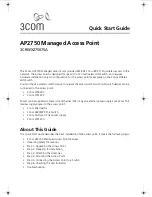
2
Cisco Aironet 1300 Series Lightweight Outdoor Access Point Mounting Instructions
78-17634-01
Introduction
Introduction
The Cisco Aironet 1300 Series Lightweight Outdoor Access Point (hereafter called an
access point
) is
designed for indoor or outdoor installations, providing differing antenna gains as well as coverage
patterns. These access points are part of the Cisco Integrated Wireless Network Solution and require no
manual configuration before they are mounted. The access point is automatically configured by a Cisco
Wireless LAN Controller (herafter called a
controller
) using the Lightweight Access Point Protocol
(LWAPP).
Operating in the 2.4-GHz band (2.400 to 2.497 GHz), using the IEEE 802.11g standard, the access point
delivers 1 to 54 Mbps data rates without the need for a license. Using a controller, you can configure the
radio settings.
In the Cisco Centralized Wireless LAN architecture, access points operate in the lightweight mode (as
opposed to autonomous mode). The access points associate to a controller. The controller manages the
configuration, firmware, and control transactions such as 802.1x authentication. In addition, all wireless
traffic is tunneled through the controller.
LWAPP is an Internet Engineering Task Force (IETF) draft protocol that defines the control messaging
for setup and path authentication and run-time operations. LWAPP also defines the tunneling mechanism
for data traffic.
In an LWAPP environment, a lightweight access point discovers a controller by using LWAPP discovery
mechanisms and then sends it an LWAPP join request. The controller sends the access point an LWAPP
join response allowing the access point to join the controller. When the access point is joined, the access
point downloads its software if the versions on the access point and controller do not match. After an
access point joins a controller, you can reassign it to any controller on your network.
LWAPP secures the control communication between the access point and controller by means of a secure
key distribution, utilizing X.509 certificates on both the access point and controller.
The access point is available with an integrated antenna or with external antenna connectors. When using
a access point with an integrated antenna, you must choose a mounting location with a clear path to the
remote antenna and orient the access point so that the antenna is positioned for maximum signal strength.
The mounting brackets in the optional installation kit has adjustment slots that facilitate the positioning
process. When using a access point with an external antenna, mount the access point in a convenient
location near the external antenna. Each external antenna has its own mounting instructions.
Note
To meet regulatory restrictions, the external antenna access point and the external antenna must be
professionally installed. The network administration or other IT professional responsible for installing and
configuring the unit is a suitable professional installer. Following installation, access to the unit should be
password protected by the network administrator to maintain regulatory compliance.
System Requirements
The access point system consists of a weather-proof unit, a power injector, a grounding block, and
optional external antennas. The access point and external antennas are typically mounted outdoors, the
grounding block is installed at the building entrance, and the power injector and the power module are
installed indoors. This document describes the access point mounting procedures only. For information
about other components, see the
“Related Documentation” section on page 38
.



































